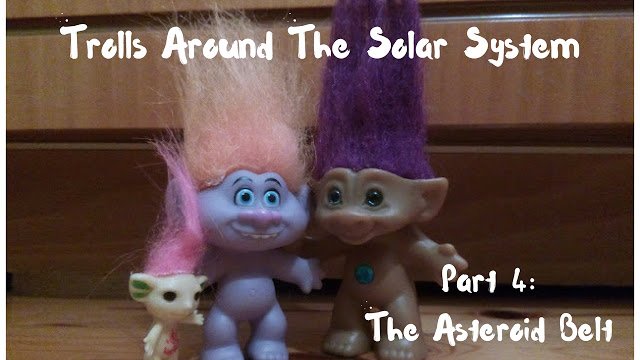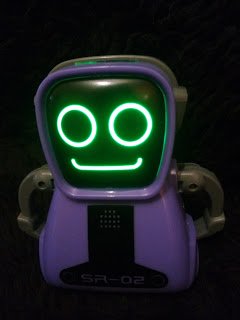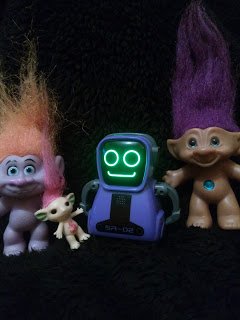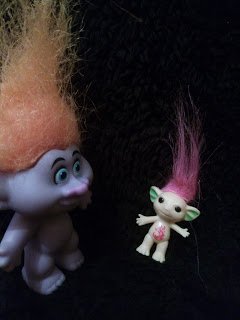
A short recap of the previous episodes:
The trolls visited the Moon where they learnt a lot of interesting facts. They came back to Earth and then left again to explore the rest of the solar system. Their first stop was Mercury, then they visited Venus, Earth's twin sister and they were last seen on Mars, where they even met Santa and got their Christmas gift. Right now they are ready to take off from the Red Planet and continue their adventure. In order to get to Jupiter, they need to cross the asteroid belt, a zone where frozen debris floats around the Sun and separates the inner rocly planets from the outer "zone of the giants".
- Hey, trolls! Nobody came up with a cool name for our robot. What do you think we should call him? X31 said.
- What about X-bot? X42 suggested.
- Or troll-bot!! X54 said.
- Hmmm, I like them both... It's a tough call, X31 sounded confused

Electronic sounds start...
- I have a name. I am T-800/Steemit Edition. It's T-800/SE or just T, the robot introduced himself.
- Ooh! That's great, it's nice to meet you T! I'm X31.
- My name is X54.
- And I'm X42.
- Nice to meet you, T-800 replied in his robotic voice.
- We were about to leave Mars and visit Jupiter, X31 said. Troll team, let's get on board!
And the troll team got on their rocket and left Mars. They are now entering the asteroid belt.
- How far is Jupiter, X31? X42 asked.
- First we need to travel through the asteroid belt, that's about two and a half to three times the distance from the Sun to the Earth, X31 said.
- Or three astronomical units (AU), T complemented.
- Right. Santa got as a really smart robot, X31 noticed.
- X31, are there asteroids floating around the asteroid zone? X54 asked.
- Yes, that's why they call it an asteroid zone. There are many millions of them, X31 answered.
- And what is an asteroid? X54 did not know.

- Asteroids are basically rocks orbiting our Sun.
- Rocks as in pebble-sized rocks, Moeraki boulders or bigger? X42 asked.
- Their sizes vary from 10 meters in diameter up to 950 kilometers, three are the bigger ones, Vesta, Pallas and Hygiea, X31 answered.
X54's eyes opened wide and he sounded scared:
- And are we going to crash on any of those rocky giants? Maybe we should choose alternative routes in Google maps!
- Don't worry, X54. They are so sparse that they are not going to hit us, X31 tried to calm him down.
The trolls are now entering the asteroid belt and X42 shouts:
- Look! I can see an asteroid! Can we get a bit closer? Oh, it has a really weird shape, it's not spherical like a planet.
- No, most asteroids have anomalous shapes, X31 said.
- And what are they made of? Rock? X54 asked.
- There are three main categories for asteroids, depending on the materials they are made of they are classified as chondrite or C-type asteroids, which are rich in carbon that gives them a dark color. Most asteroids are C-type. There are stony or S-type asteroids made of silicate and nickel-iron. And finally, there are metallic, M-type asteroids from nickel-iron. Their composition depends on how far from the Sun they are found, X31 explained.
- Interesting fact: Some asteroids might even have a moon or two, T said.
- And some might form a binary system, where two almost equal size asteroids orbit each other, X31 added.
- But how did they form? X42 asked.
- Rubble, T said.
- Yes, X31 started explaining, asteroids are the remnants of our solar system, material that was unable to form a planet while our solar system was forming. It's funny how the asteroids closer to the inner planets are mostly S-type, containing elements similar to the rocky planets; whereas asteroids closer to the oter plnets are mostl C-type, rich in carbon like the two gas giants of our solar system, Jupiter and Saturn.
- I don't see how this is funny, X42 said.
- It's not make-me-laugh funny, X31 said, I meant to say that the asteroids are the leftovers of the planets they are closer at. Also, their mass is so small that even if they could have mixed together, they would only have formed a dwarf planet.
- Dwarf planet? Like the ones in Snowhite? X54 was confused.
- Dwarf planets are planets, they are spherical and orbit around a star only they are smaller and their gravity is not strong enough to clear any other floating objects and pull them on their surface, X31 said.

- There is a dwarf planet in the asteroid belt, it's called Ceres, T mentioned.
- Oh, yes! I almost forgot about Ceres. It's a dwarf planet with ice masses, many times defined as an asteroid too. Tell them about Dawn, T-800.
- Dawn was a robotic mission of NASA. It studied Vesta for one year, from 2011 to 2012 and then continued to Ceres in 2015. Dawn discovered that Ceres was covered by oceans. Water and ammonia reacted with silicate rocks. The water froze and ice sublimed over time, so salts and other elements are left covering the dwarf planet.
- Well said, X31 praised T-800.
- Thank you.
- Will it take too long until we reach Jupiter? X54 asked. I can't wait to see the famous spot!

- Be patient, X54. Space travel takes time, X42 said. If you're bored just go check some of @trumpman's posts. I think he got out some really cool sharks today.
- Sharks?! No way! They scare the hell out of me! I think I'll read that post on Christmas-tree-slug-critters, it was less scary...
And the trolls' DIY rocket kept going through the asteroid belt until it reaches its next destination, Jupiter.
To be continued...
References
space.com
solarsystem.nasa.gov_1
solarsystem.nasa.gov_2
phys.org
dawn.jpl.nasa.gov
*Images by @ruth-girl

Thank you for stopping by and reading this. If you want to see more of my stuff, you can go through the links below:
- A New Year, A Full Moon And Belated New Year's Fireworks
- A 2017 Review And A Happy New Year!
- Let's Learn Something Cool - My Red Is Not The Same As Yours
- Diamonds And Rust - A Short Story Of Science Fiction
- Bizarre Natural Phenomena Vol.37 - Cold And Dirty "Lava" (Mud Volcanoes)

Until my next post,
Steem on and keep smiling, people!

